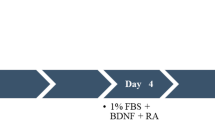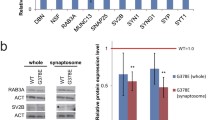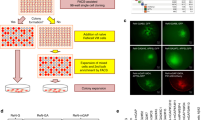Abstract
Cholinergic transmission is critical to high-order brain functions such as memory, learning, and attention. Alzheimer’s disease (AD) is characterized by cognitive decline associated with a specific degeneration of cholinergic neurons. No effective treatment to prevent or reverse the symptoms is known. Part of this might be due to the lack of in vitro models that effectively mimic the relevant features of AD. Here, we describe the characterization of an AD in vitro model using the SH-SY5Y cell line. Exponentially growing cells were maintained in DMEM/F12 medium and differentiation was triggered by the combination of retinoic acid (RA) and BDNF. Both acetylcholinesterase (AChE) and choline acetyltransferase (ChAT) enzymatic activities and immunocontent were determined. For mimicking tau and amyloid-β pathology, RA + BDNF-differentiated cells were challenged with okadaic acid (OA) or soluble oligomers of amyloid-β (AβOs) and neurotoxicity was evaluated. RA + BDNF-induced differentiation resulted in remarkable neuronal morphology alterations characterized by increased neurite density. Enhanced expression and enzymatic activities of cholinergic markers were observed compared to RA-differentiation only. Combination of sublethal doses of AβOs and OA resulted in decreased neurite densities, an in vitro marker of synaptopathy. Challenging RA + BDNF-differentiated SH-SY5Y cells with the combination of sublethal doses of OA and AβO, without causing considerable decrease of cell viability, provides an in vitro model which mimics the early-stage pathophysiology of cholinergic neurons affected by AD.





Similar content being viewed by others
Abbreviations
- AD:
-
Alzheimer’s disease
- DMEM:
-
Dulbecco’s Modified Eagle Medium
- FBS:
-
Fetal bovine serum
- RA:
-
Retinoic acid
- BDNF:
-
Brain-derived neurotrophic factor
- AChE:
-
Acetylcholinesterase
- ChAT:
-
Choline acetyltransferase
- AβOs:
-
Amyloid-β oligomers
- AO:
-
Okadaic acid
- MTT:
-
3-(4,5-Dimethylthiazol-2il)-2,5-diphenyltetrazolium bromide
- DAT:
-
Dopamine transporter
- Aβ:
-
Amyloid-β
- BFC:
-
Basal forebrain complex
- APP:
-
Amyloid precursor protein
- ACh:
-
Acetylcholine
- CDK5:
-
Cyclin-dependent kinase
References
Moller HJ, Graeber MB (1998) The case described by Alois Alzheimer in 1911. Historical and conceptual perspectives based on the clinical record and neurohistological sections. Eur Arch Psychiatry Clin Neurosci 248:111–122
Forman MS, Trojanowski JQ, Lee VM (2004) Neurodegenerative diseases: a decade of discoveries paves the way for therapeutic breakthroughs. Nat Med 10:1055–1063
Oda Y, Nakanishi I (2000) The distribution of cholinergic neurons in the human central nervous system. Histol Histopathol 15:825–834
Nyakas C, Granic I, Halmy LG, Banerjee P, Luiten PGM (2011) The basal forebrain cholinergic system in aging and dementia. Rescuing cholinergic neurons from neurotoxic amyloid-β42 with memantine. Behav Brain Res 221:594–603
Reitz C, Mayeux R (2014) Alzheimer disease: epidemiology, diagnostic criteria, risk factors and biomarkers. Biochem Pharmacol 88:640–651
Adalbert R, Gilley J, Coleman MP (2007) Aβ, tau and ApoE4 in Alzheimer’s disease: the axonal connection. Trends Mol Med 13:135–142
Pagani L, Eckert A (2011) Amyloid-β interaction with mitochondria. Int J Alzheimers Dis 2011:925050
Deshpande A, Mina E, Glabe C, Busciglio J (2006) Different conformations of amyloid beta induce neurotoxicity by distinct mechanisms in human cortical neurons. J Neurosci 26:6011–6018
Gouras GK, Tampellini D, Takahashi RH, Capetillo-Zarate E (2010) Intraneuronal amyloid-β accumulation and synapse pathology in Alzheimer’s disease. Acta Neuropathol 119:523–541
Wang H-W, Pasternak JF, Kuo H, Ristic H, Lambert MP, Chromy B et al (2002) Soluble oligomers of beta amyloid (1-42) inhibit long-term potentiation but not long-term depression in rat dentate gyrus. Brain Res 924:133–140
Agholme L, Lindström T, Kågedal K, Marcusson J, Hallbeck M, Kgedal K et al (2010) An in vitro model for neuroscience: differentiation of SH-SY5Y cells into cells with morphological and biochemical characteristics of mature neurons. J Alzheimers Dis 20:1069–1082
Carolindah MN, Rosli R, Adam A, Nordin N (2013) An overview of in vitro research models for Alzheimer’s disease. Regen Res 2:8–13
Gu H, Li L, Cui C, Zhao Z, Song G (2017) Overexpression of let-7a increases neurotoxicity in a PC12 cell model of Alzheimer’s disease via regulating autophagy. Exp Ther Med 14:3688–3698
Kovalevich J, Langford D (2013) Considerations for the use of SH-SY5Y neuroblastoma cells in neurobiology. Methods Mol Biol 1078:9–21
Choi SH, Kim YH, Hebisch M, Sliwinski C, Lee S, D’Avanzo C et al (2014) A three-dimensional human neural cell culture model of Alzheimer’s disease. Nature.
Biedler JL, Roffler-tarlov S, Schachner M, Freedman LS (1978) Multiple neurotransmitter synthesis by human neuroblastoma cell lines and clones. Cancer Res:3751–3757
Påhlman S, Ruusala a I, Abrahamsson L, Mattsson ME, Esscher T (1984) Retinoic acid-induced differentiation of cultured human neuroblastoma cells: a comparison with phorbolester-induced differentiation. Cell Differ 14:135–144
Påhlman S, Hoehner JC, Nånberg E, Hedborg F, Fagerström S, Gestblom C et al (1995) Differentiation and survival influences of growth factors in human neuroblastoma. Eur J Cancer 31A:453–458
Arcangeli A, Rosati B, Crociani O, Cherubini A, Fontana L, Passani B et al (1999) Modulation of HERG current and herg gene expression during retinoic acid treatment of human neuroblastoma cells: potentiating effects of BDNF. J Neurobiol 40:214–225
Encinas M, Iglesias M, Liu Y, Wang H, Muhaisen A, Cen V et al (2000) Sequential treatment of SH-SY5Y cells with retinoic acid and brain-derived neurotrophic factor gives rise to fully differentiated , neurotrophic factor-dependent. J Neurochem 75:991–1003
Lopes FM, Schröder R, da Frota MLC, Zanotto-Filho A, Müller CB, Pires AS et al (2010) Comparison between proliferative and neuron-like SH-SY5Y cells as an in vitro model for Parkinson disease studies. Brain Res 1337:85–94
Constantinescu R, Constantinescu AT, Reichmann H, Janetzky B (2007) Neuronal differentiation and long-term culture of the human neuroblastoma line SH-SY5Y. J Neural Transm:17–28
Lopes FM, Londero GF, de Medeiros LM, da Motta LL, Behr GA, de Oliveira VA et al (2012) Evaluation of the neurotoxic/neuroprotective role of organoselenides using differentiated human neuroblastoma SH-SY5Y cell line challenged with 6-hydroxydopamine. Neurotox Res 22:138–149
Kaplan DR, Matsumoto K, Lucarelli E, Thiele CJ (1993) Induction of TrkB by retinoic acid mediates biologic responsiveness to BDNF and differentiation of human neuroblastoma cells. Neuron Neuron, Cell Press 11:321–331
Edsjö A, Lavenius E, Nilsson H, Hoehner JC, Simonsson P, Culp LA et al (2003) Expression of trkB in human neuroblastoma in relation to MYCN expression and retinoic acid treatment. Lab Investig 83:813–823
Ward NL, Hagg T (2000) BDNF is needed for postnatal maturation of basal forebrain and neostriatum cholinergic neurons in vivo. Exp Neurol 162:297–310
Schliebs R, Arendt T (2011) The cholinergic system in aging and neuronal degeneration. Behav Brain Res 221:555–563
Paul S, Jeon WK, Bizon JL, Han J-S (2015) Interaction of basal forebrain cholinergic neurons with the glucocorticoid system in stress regulation and cognitive impairment. Front Aging Neurosci 7:1–11
Ozen Irmak S, de Lecea L (2014) Basal forebrain cholinergic modulation of sleep transitions. Sleep 37:1941–1951
Haam J, Yakel JL (2017) Cholinergic modulation of the hippocampal region and memory function. J Neurochem 142:111–121
Grothe MJ, Schuster C, Bauer F, Heinsen H, Prudlo J, Teipel SJ (2014) Atrophy of the cholinergic basal forebrain in dementia with Lewy bodies and Alzheimer’s disease dementia. J Neurol:71–73
Nilbratt M, Porras O, Marutle A, Hovatta O, Nordberg A (2010) Neurotrophic factors promote cholinergic differentiation in human embryonic stem cell-derived neurons. J Cell Mol Med 14:1476–1484
Sharow KA, Temkin B, Asson-Batres MA (2012) Retinoic acid stability in stem cell cultures. Int J Dev Biol 56:273–278
Gautier L, Cope L, Bolstad BM, Irizarry RA (2004) affy—analysis of Affymetrix GeneChip data at the probe level. Bioinformatics 20:307–315
Leek JT, Johnson WE, Parker HS, Jaffe AE, Storey JD (2012) The sva package for removing batch effects and other unwanted variation in high-throughput experiments. Bioinformatics 28:882–883
Subramanian A, Tamayo P, Mootha VK, Mukherjee S, Ebert BL (2005) Gene set enrichment analysis: a knowledge-based approach for interpreting genome-wide. PNAS 102:15545–15550
Ellman GL, Courtney KD, Andres V, Featherstone RM (1961) A new and rapid colorimetric determination of acetylcholinesterase activity. Biochem Pharmacol 7:88–95
Chao L, Wolfgram F (1972) Spectrophotometric for choline acetyltransferase. Anal Biochem 46:114–118
Klein WL (2002) Aβ toxicity in Alzheimer’s disease: globular oligomers (ADDLs) as new vaccine and drug targets. Neurochem Int 41:345–352
Stine WB, Dahlgren KN, G a K, LaDu MJ (2003) In vitro characterization of conditions for amyloid-beta peptide oligomerization and fibrillogenesis. J Biol Chem 278:11612–11622
Oda Y (1999) Choline acetyltransferase: the structure, distribution and pathologic changes in the central nervous system. Pathol Int 49:921–937
Kamat PK, Tota S, Saxena G, Shukla R, Nath C (2010) Okadaic acid (ICV) induced memory impairment in rats: a suitable experimental model to test anti-dementia activity. Brain Res 1309:66–74
Jack CR, Holtzman DM (2013) Biomarker modeling of Alzheimer’s disease. Neuron 80:1347–1358
Schliebs R, Arendt T (2006) The significance of the cholinergic system in the brain during aging and in Alzheimer’s disease. J Neural Transm 113:1625–1644
Douchamps V, Mathis C (2017) A second wind for the cholinergic system in Alzheimer’s therapy. Behav Pharmacol 28:112–123
Butcher LL, Oh JD, Woolf NJ (1993) Cholinergic neurons identified by in sity hybridization histochemistry. In: Cholinergic Function and Dysfunction, AC Cuello, Ed., pp.1–8, Elsevier, Amsterdam, 1993
Mok KY, Jones EL, Hanney M, Harold D, Sims R, Williams J et al (2014) Polymorphisms in BACE2 may affect the age of onset Alzheimer’s dementia in down syndrome. Neurobiol Aging 35:1513.e1–1513.e5
Ma Z, Jiang W, Zhang EE (2016) Orexin signaling regulates both the hippocampal clock and the circadian oscillation of Alzheimer’s disease-risk genes. Sci Rep 6:36035
Kelleher RJ, Shen J (2017) Presenilin-1 mutations and Alzheimer’s disease. Proc Natl Acad Sci 114:629–631
Endres K, Deller T (2017) Regulation of alpha-secretase ADAM10 in vitro and in vivo: genetic, epigenetic, and protein-based mechanisms. Front Mol Neurosci 10:1–18
Liu SL, Wang C, Jiang T, Tan L, Xing A, Yu JT (2016) The role of Cdk5 in Alzheimer’s disease. Mol Neurobiol 53:4328–4342
van Pelt J, van Ooyen A, Uylings HBM (2014) Axonal and dendritic density field estimation from incomplete single-slice neuronal reconstructions. Front Neuroanat 8:1–16
Su JH, Cummings BJ, Cotman CW (1994) Early phosphorylation of tau in Alzheimer’s disease occurs at Ser-202 and is preferentially located within neurites. Neuroreport 5:2358–2362
Olivero G, Grilli M, Chen J, Preda S, Mura E, Govoni S et al (2014) Effects of soluble β-amyloid on the release of neurotransmitters from rat brain synaptosomes. Front Aging Neurosci 6:166
Franze K, Gerdelmann J, Weick M, Betz T, Pawlizak S, Lakadamyali M et al (2009) Neurite branch retraction is caused by a threshold-dependent mechanical impact. Biophys J 97:1883–1890
Klein WL (2013) Synaptotoxic amyloid-beta oligomers: a molecular basis for the cause, diagnosis, and treatment of Alzheimer’s disease? J Alzheimers Dis 33(Suppl 1):S49–S65
Lasagna-Reeves CA, Castillo-Carranza DL, Sengupta U, Sarmiento J, Troncoso J, Jackson GR et al (2012) Identification of oligomers at early stages of tau aggregation in Alzheimer’s disease. FASEB J 26:1946–1959
Amaro M, Kubiak-Ossowska K, Birch DJS, Rolinski OJ (2013) Initial stages of beta-amyloid Aβ 1−40 and Aβ 1−42 oligomerization observed using fluorescence decay and molecular dynamics analyses of tyrosine. Methods Appl Fluoresc 1:15006
Funding
This study was supported by the Brazilian funds MCTI/CNPq INCT-TM/CAPES/FAPESP (465458/2014-9), CNPq/MS/SCTIE/DECIT - Pesquisas Sobre Doenças Neurodegenerativas (466989/2014-8), and PRONEX/FAPERGS (16/2551-0000499-4). FK received a fellowship from MCT/CNPq [306439/2014-0]. ERZ receives financial support from CAPES [88881.141186/2017-01].
Author information
Authors and Affiliations
Corresponding author
Additional information
Publisher’s Note
Springer Nature remains neutral with regard to jurisdictional claims in published maps and institutional affiliations.
Rights and permissions
About this article
Cite this article
de Medeiros, L.M., De Bastiani, M.A., Rico, E.P. et al. Cholinergic Differentiation of Human Neuroblastoma SH-SY5Y Cell Line and Its Potential Use as an In vitro Model for Alzheimer’s Disease Studies. Mol Neurobiol 56, 7355–7367 (2019). https://doi.org/10.1007/s12035-019-1605-3
Received:
Accepted:
Published:
Issue Date:
DOI: https://doi.org/10.1007/s12035-019-1605-3




